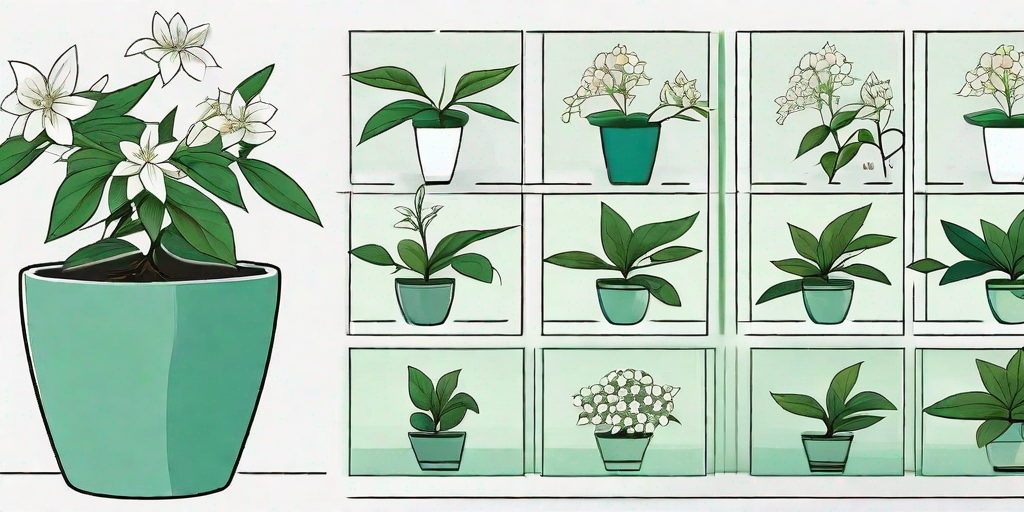
If you've ever been captivated by the intoxicating aroma of jasmine on a warm summer evening, you might have thought about growing your own. But where to start? Fear not, budding horticulturists, this guide is here to help you navigate the fragrant path to jasmine propagation success.
Understanding Jasmine: The Basics
Before we dive into the propagation process, let's take a moment to understand jasmine. It's a bit like getting to know someone before you invite them to move in. You wouldn't want to find out too late that your new roommate is a nocturnal party animal, would you?
Jasmine is a genus of shrubs and vines in the olive family. Known for their stunning, fragrant flowers, they are native to tropical and warm temperate regions. There are around 200 species, but for the purpose of this guide, we'll focus on the common jasmine (Jasminum officinale).
The Life and Times of Jasmine
Jasmine plants are perennials, meaning they live for many years. They are deciduous or evergreen and can grow up to 15 feet tall. They prefer full sun to partial shade and well-drained soil. They are also quite the social butterflies, often used in gardens for their ability to climb trellises or walls.
Flowering usually occurs in summer or fall, but some species can bloom throughout the year. The flowers are typically white, although some species have yellow flowers. And let's not forget that heavenly scent, which is often more potent at night to attract pollinating moths.
Propagation: The How-To
Now that we've gotten to know jasmine a bit better, let's move on to the main event: propagation. This is where the magic happens, folks. It's like a DIY project, but instead of ending up with a questionable-looking bookshelf, you'll have a beautiful, fragrant plant.
Materials Needed
First things first, gather your materials. You'll need a sharp knife or pruning shears, a pot with drainage holes, potting soil, a plastic bag, and a rubber band. And, of course, a healthy jasmine plant from which to take cuttings. Don't worry, it won't hold a grudge.
Step-by-Step Guide
- Choose a healthy, vigorous shoot from your jasmine plant. Look for one that's mature but not old, kind of like the George Clooney of plant shoots.
- Cut a 4-6 inch piece from the shoot, making sure to include at least three sets of leaves. This will be your cutting.
- Remove the leaves from the bottom half of the cutting. This will encourage root growth.
- Fill your pot with potting soil and make a hole in the center. Insert the cutting into the hole and firm the soil around it.
- Place the pot in a plastic bag and secure it with a rubber band. This creates a mini greenhouse, keeping the cutting moist and warm.
- Place the pot in a warm, bright location, but out of direct sunlight. Check the cutting regularly and water if the soil begins to dry out.
- After 4-6 weeks, the cutting should have developed roots. You can check by gently tugging on the cutting. If it resists, congratulations, you've successfully propagated a jasmine plant!
Common Problems and Solutions
Like any good relationship, growing jasmine isn't always smooth sailing. There can be pests, diseases, and other issues. But don't worry, we've got solutions for those too.
Pests
Jasmine plants can be affected by pests such as aphids, mealybugs, and spider mites. If you notice small, discolored spots on your plant or a sticky substance on the leaves or surrounding surfaces, you might have a pest problem. But don't panic, a simple solution of water and dish soap sprayed on the affected areas can often take care of these unwelcome guests.
Diseases
Jasmine can also be susceptible to diseases such as leaf spot and root rot. These can be caused by overwatering or poor drainage. To prevent these issues, make sure your plant has well-draining soil and don't water it too frequently. If your plant does get sick, don't lose hope. Often, removing the affected parts and adjusting your care routine can nurse it back to health.
Frequently Asked Questions
- Can I grow jasmine indoors?
- Yes, jasmine can be grown indoors, as long as it gets enough light and is kept in a well-drained pot.
- How often should I water my jasmine plant?
- Jasmine prefers to be kept slightly moist, but not soaking wet. Watering once a week should be sufficient in most cases, but adjust as necessary depending on the conditions.
- Why isn't my jasmine plant flowering?
- There could be several reasons. It might not be getting enough light, it could be too young (jasmine plants usually start flowering in their second or third year), or it could be a nutrient issue. Try moving it to a sunnier spot, being patient, or feeding it a high-potassium fertilizer.
Conclusion
So there you have it, a comprehensive guide to growing your own jasmine. With a bit of patience and care, you'll soon be enjoying the sweet scent of success. And remember, every gardener has a green thumb, it's just a matter of finding the right plant. Happy growing!















